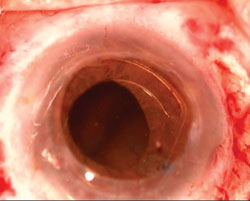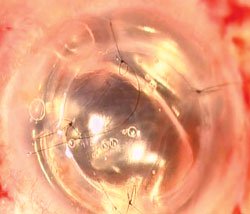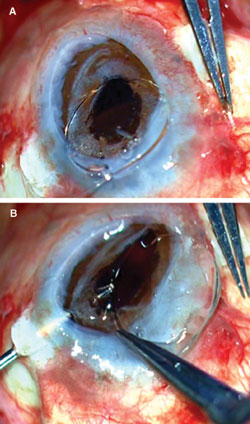Take steps to avoid an expulsive hemorrhage during surgery
Click Here to Manage Email Alerts
 Amar Agarwal |
Expulsive hemorrhage is one of the most devastating complications for both the surgeon and the patient. Unlike other complications, the surgeon is generally caught unaware and unprepared. It can occur during any kind of intraocular surgery, from phacoemulsification to vitreoretinal surgery, but certain surgeries are more predisposed to developing an expulsive hemorrhage, such as intracapsular cataract extraction and open-sky procedures including penetrating keratoplasty. Expulsive hemorrhage is more commonly seen in elderly patients with generalized arteriosclerosis or hypertension.
Patients with a history of expulsive hemorrhage are at higher risk of developing an expulsive hemorrhage in the other eye as well. Local ocular conditions that predispose to an expulsive hemorrhage include glaucoma, increased IOP, low scleral rigidity and high myopia. Other intraoperative factors that can be important include sudden rise in blood pressure, a positive Valsalva maneuver such as coughing, straining, squeezing of the lids by the patient, a tight lid speculum causing pressure on the globe or vitreous loss during surgery. Expulsive hemorrhage has an incidence of about 0.05% to 0.4%. About 50% of cases occur within the first few days of surgery. An expulsive hemorrhage may be self-limiting and confined to only one or two quadrants. On the other hand, it may lead to an expulsive bleeding with extrusion of intraocular contents, which is more likely if the eye is open at the same time as the hemorrhage.
Expulsive hemorrhage
Sudden hypotony caused by opening the globe leads to lowering of the IOP to atmospheric levels. This leaves the intraocular vascular bed unsupported, leading to a rupture of one of the ciliary vessels. This causes a suprachoroidal bleed that lifts up the retina and choroid, leading in turn to stretching and rupture of more of the posterior ciliary vessels. The process can cascade, eventually resulting in extrusion of all intraocular contents. Bleeding generally starts from one of the short posterior ciliary arteries. The vessels are especially prone to rupture if they are also necrotic secondary to glaucoma or arteriosclerosis. Events might also begin with a serous choroidal detachment that leads to a sudden stretching of the ciliary vessels, leading to their rupture.
 Figures 1a and 1b. Expulsive hemorrhage. (1a) Early stage of an expulsive hemorrhage with vitreous prolapse and wound gape. (1b) Late stage of the same case with extrusion of intraocular contents, including the retina. Images: Agarwal A |
 Figure 2. A dark, expanding choroidal mass is seen, signifying impending expulsive hemorrhage. Prompt action may save the eye. |
Expulsive hemorrhage is recognized intraoperatively as a shallowing of the anterior chamber, spontaneous expulsion of the lens or IOL, progressive vitreous loss, wound gape, a dark, expanding choroidal mass along with hemorrhage through the wound and finally the appearance of the retina and choroid in the wound (Figures 1a, 1b and 2). With a closed globe or in eyes with self-sealing incisions, such as in phacoemulsification, an expulsive hemorrhage is recognized as shallowing of the chamber and progressive firmness of the globe.
Prevention
Patients at high risk need maximum ocular hypotension preoperatively with acetazolamide, liquid glycerol and intravenous mannitol. The blood pressure should be lowered in hypertensives, and adrenaline should be avoided during surgery. A good block with application of a Super Pinky ball for decreasing IOP as well as intraorbital pressure is invaluable. A facial block may also be given to avoid lid squeezing by the patient. Surgery should be done with the head end elevated to avoid venous congestion.
 Figure 3. The donor cornea with a top hat-shaped cut created by the IntraLase is seen. A similar cut is also made on the recipient cornea. The donor thus fits into the recipient bed like a jigsaw puzzle. |
 Figure 4. Placement of just the four cardinal sutures allows creation of an airtight chamber in IntraLase-enabled shaped keratoplasties such as top hat, mushroom or zigzag keratoplasty. |
Pre-placed sutures in extracapsular cataract surgery help in rapid closure of the wound. Slow decompression of the anterior chamber, especially in eyes with glaucoma or in eyes with low scleral rigidity, is important. Penetrating keratoplasty is associated with a higher risk of intraoperative hemorrhage because of the longer open-sky time. The donor graft must always be prepared and kept ready before removing the recipient button and should rapidly be sutured in place. IntraLase-enabled keratoplasty can be performed to obtain shaped cuts in both the donor and recipient buttons that fit together like jigsaw puzzles (Figure 3). With this procedure, application of just the four cardinal sutures rapidly results in an airtight chamber (Figure 4). It is advisable to not cut the host button fully, but leave it attached by a hinge in cases of eyes requiring a longer open-sky time because of the need of associated pupilloplasty or cataract extraction. This allows rapid closure of the globe in case of a sudden event. In penetrating keratoplasty with secondary IOL planned, as compared with a sutured scleral-fixated IOL, the glued IOL decreases open-sky time by allowing rapid exteriorization of haptics, after which the graft can be sutured in place (Figures 5a and 5b). The haptics are then tucked intrasclerally after the globe is formed well. Finally, fibrin glue is applied to seal the haptics to the sclera. An anterior chamber IOL might not be preferred in this case because of the decreased IOL-to-endothelium distance.
 Figures 5a and 5b. A combined penetrating keratoplasty with a glued IOL is seen. (5a) One haptic of the IOL has been exteriorized under a scleral flap using 23-gauge end-gripping MST forceps. (5b) The trailing haptic is then grasped with the forceps and similarly exteriorized. Both haptics are then tucked intrasclerally. Finally, fibrin glue is applied to seal the haptic to the sclera. |
Management
If the surgeon is faced with an expulsive hemorrhage, the first priority is to stem the intraocular hemorrhage as quickly as possible. This can be done by rapid suturing or even more quickly by applying the finger over the wound to plug it. This was first published by Morris Osher, MD. At the same time, posterior sclerotomies are made to allow external drainage of the blood and to avoid lifting of the choroid and retina by the expanding suprachoroidal hemorrhage. This combination may prove effective in halting the hemorrhage and allowing the blood to drain externally.
Conclusion
An expulsive hemorrhage usually strikes at a time when the surgeon is both unaware and unprepared. The final prognosis depends on the time of hemorrhage, the size of the vessel involved and speedy therapy. Rapid recognition and institution of appropriate measures can help save an otherwise unsalvageable eye.

- Amar Agarwal, MS, FRCS, FRCOphth, is director of Dr. Agarwal’s Eye Hospital and Eye Research Centre. Prof. Agarwal is the author of several books published by SLACK Incorporated, publisher of Ocular Surgery News, including Phaco Nightmares: Conquering Cataract Catastrophes, Bimanual Phaco: Mastering the Phakonit/MICS Technique, Dry Eye: A Practical Guide to Ocular Surface Disorders and Stem Cell Surgery and Presbyopia: A Surgical Textbook. He can be reached at 19 Cathedral Road, Chennai 600 086, India; fax: 91-44-28115871; e-mail: dragarwal@vsnl.com; website: www.dragarwal.com.
